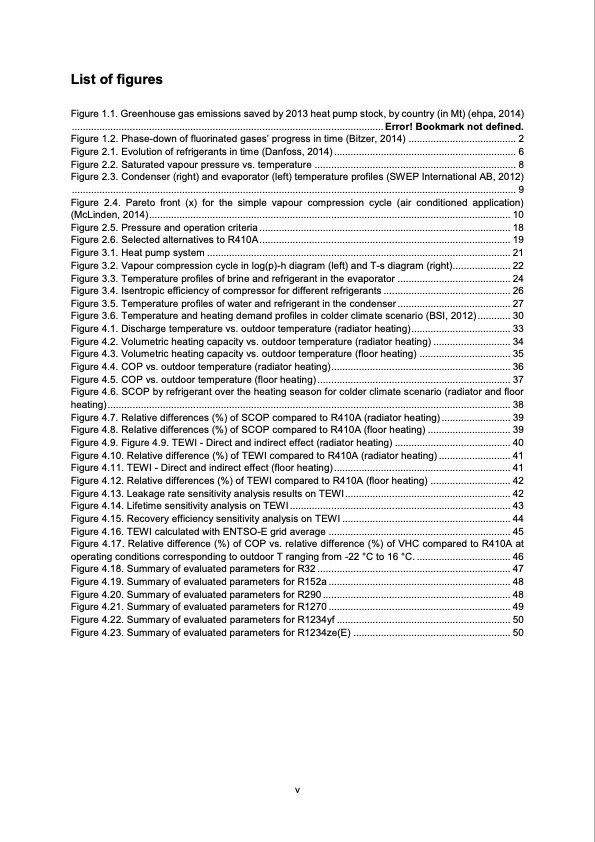
PDF Publication Title:
Text from PDF Page: 006
List of figures Figure 1.1. Greenhouse gas emissions saved by 2013 heat pump stock, by country (in Mt) (ehpa, 2014) ................................................................................................................. Error! Bookmark not defined. Figure 1.2. Phase-down of fluorinated gases’ progress in time (Bitzer, 2014) ....................................... 2 Figure 2.1. Evolution of refrigerants in time (Danfoss, 2014) .................................................................. 6 Figure 2.2. Saturated vapour pressure vs. temperature ......................................................................... 8 Figure 2.3. Condenser (right) and evaporator (left) temperature profiles (SWEP International AB, 2012) ................................................................................................................................................................. 9 Figure 2.4. Pareto front (x) for the simple vapour compression cycle (air conditioned application) (McLinden, 2014)................................................................................................................................... 10 Figure 2.5. Pressure and operation criteria ........................................................................................... 18 Figure 2.6. Selected alternatives to R410A ........................................................................................... 19 Figure 3.1. Heat pump system .............................................................................................................. 21 Figure 3.2. Vapour compression cycle in log(p)-h diagram (left) and T-s diagram (right)..................... 22 Figure 3.3. Temperature profiles of brine and refrigerant in the evaporator ......................................... 24 Figure 3.4. Isentropic efficiency of compressor for different refrigerants .............................................. 26 Figure 3.5. Temperature profiles of water and refrigerant in the condenser ......................................... 27 Figure 3.6. Temperature and heating demand profiles in colder climate scenario (BSI, 2012) ............ 30 Figure 4.1. Discharge temperature vs. outdoor temperature (radiator heating).................................... 33 Figure 4.2. Volumetric heating capacity vs. outdoor temperature (radiator heating) ............................ 34 Figure 4.3. Volumetric heating capacity vs. outdoor temperature (floor heating) ................................. 35 Figure 4.4. COP vs. outdoor temperature (radiator heating)................................................................. 36 Figure 4.5. COP vs. outdoor temperature (floor heating) ...................................................................... 37 Figure 4.6. SCOP by refrigerant over the heating season for colder climate scenario (radiator and floor heating).................................................................................................................................................. 38 Figure 4.7. Relative differences (%) of SCOP compared to R410A (radiator heating) ......................... 39 Figure 4.8. Relative differences (%) of SCOP compared to R410A (floor heating) .............................. 39 Figure 4.9. Figure 4.9. TEWI - Direct and indirect effect (radiator heating) .......................................... 40 Figure 4.10. Relative difference (%) of TEWI compared to R410A (radiator heating) .......................... 41 Figure 4.11. TEWI - Direct and indirect effect (floor heating)................................................................ 41 Figure 4.12. Relative differences (%) of TEWI compared to R410A (floor heating) ............................. 42 Figure 4.13. Leakage rate sensitivity analysis results on TEWI............................................................ 42 Figure 4.14. Lifetime sensitivity analysis on TEWI................................................................................ 43 Figure 4.15. Recovery efficiency sensitivity analysis on TEWI ............................................................. 44 Figure 4.16. TEWI calculated with ENTSO-E grid average .................................................................. 45 Figure 4.17. Relative difference (%) of COP vs. relative difference (%) of VHC compared to R410A at operating conditions corresponding to outdoor T ranging from -22 °C to 16 °C. .................................. 46 Figure 4.18. Summary of evaluated parameters for R32 ...................................................................... 47 Figure 4.19. Summary of evaluated parameters for R152a .................................................................. 48 Figure 4.20. Summary of evaluated parameters for R290 .................................................................... 48 Figure 4.21. Summary of evaluated parameters for R1270 .................................................................. 49 Figure 4.22. Summary of evaluated parameters for R1234yf ............................................................... 50 Figure 4.23. Summary of evaluated parameters for R1234ze(E) ......................................................... 50 vPDF Image | Next generation of refrigerants for residential heat pump systems

PDF Search Title:
Next generation of refrigerants for residential heat pump systemsOriginal File Name Searched:
MartinaLonghini_ThesisReport.pdfDIY PDF Search: Google It | Yahoo | Bing
CO2 Organic Rankine Cycle Experimenter Platform The supercritical CO2 phase change system is both a heat pump and organic rankine cycle which can be used for those purposes and as a supercritical extractor for advanced subcritical and supercritical extraction technology. Uses include producing nanoparticles, precious metal CO2 extraction, lithium battery recycling, and other applications... More Info
Heat Pumps CO2 ORC Heat Pump System Platform More Info
| CONTACT TEL: 608-238-6001 Email: greg@infinityturbine.com | RSS | AMP |